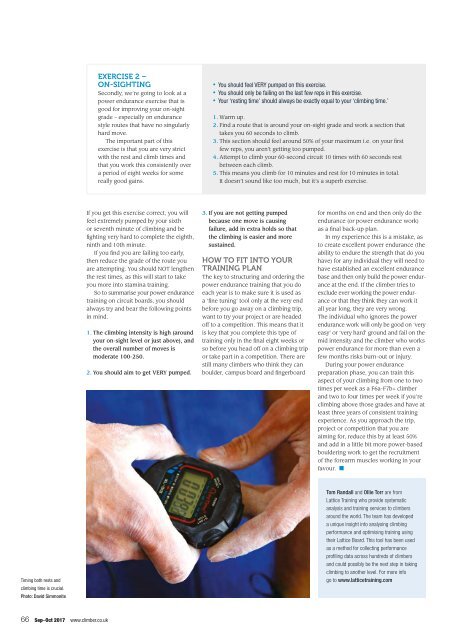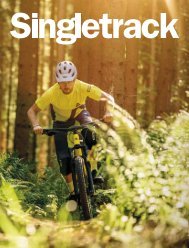You also want an ePaper? Increase the reach of your titles
YUMPU automatically turns print PDFs into web optimized ePapers that Google loves.
Exercise 2 –<br />
On-sighting<br />
Secondly, we’re going to look at a<br />
power endurance exercise that is<br />
good for improving your on-sight<br />
grade – especially on endurance<br />
style routes that have no singularly<br />
hard move.<br />
The important part of this<br />
exercise is that you are very strict<br />
with the rest and climb times and<br />
that you work this consistently over<br />
a period of eight weeks for some<br />
really good gains.<br />
• You should feel VERY pumped on this exercise.<br />
• You should only be failing on the last few reps in this exercise.<br />
• Your ‘resting time’ should always be exactly equal to your ‘climbing time.’<br />
1. Warm up.<br />
2. Find a route that is around your on-sight grade and work a section that<br />
takes you 60 seconds to climb.<br />
3. This section should feel around 50% of your maximum i.e. on your first<br />
few reps, you aren’t getting too pumped.<br />
4. Attempt to climb your 60-second circuit 10 times with 60 seconds rest<br />
between each climb.<br />
5. This means you climb for 10 minutes and rest for 10 minutes in total.<br />
It doesn’t sound like too much, but it’s a superb exercise.<br />
If you get this exercise correct, you will<br />
feel extremely pumped by your sixth<br />
or seventh minute of climbing and be<br />
fighting very hard to complete the eighth,<br />
ninth and 10th minute.<br />
If you find you are failing too early,<br />
then reduce the grade of the route you<br />
are attempting. You should NOT lengthen<br />
the rest times, as this will start to take<br />
you more into stamina training.<br />
So to summarise your power endurance<br />
training on circuit boards, you should<br />
always try and bear the following points<br />
in mind.<br />
1. The climbing intensity is high (around<br />
your on-sight level or just above), and<br />
the overall number of moves is<br />
moderate 100-250.<br />
2. You should aim to get VERY pumped.<br />
3. If you are not getting pumped<br />
because one move is causing<br />
failure, add in extra holds so that<br />
the climbing is easier and more<br />
sustained.<br />
How to fit into your<br />
training plan<br />
The key to structuring and ordering the<br />
power endurance training that you do<br />
each year is to make sure it is used as<br />
a ‘fine tuning’ tool only at the very end<br />
before you go away on a climbing trip,<br />
want to try your project or are headed<br />
off to a competition. This means that it<br />
is key that you complete this type of<br />
training only in the final eight weeks or<br />
so before you head off on a climbing trip<br />
or take part in a competition. There are<br />
still many climbers who think they can<br />
boulder, campus board and fingerboard<br />
for months on end and then only do the<br />
endurance (or power endurance work)<br />
as a final back-up plan.<br />
In my experience this is a mistake, as<br />
to create excellent power endurance (the<br />
ability to endure the strength that do you<br />
have) for any individual they will need to<br />
have established an excellent endurance<br />
base and then only build the power endurance<br />
at the end. If the climber tries to<br />
exclude ever working the power endurance<br />
or that they think they can work it<br />
all year long, they are very wrong.<br />
The individual who ignores the power<br />
endurance work will only be good on ‘very<br />
easy’ or ‘very hard’ ground and fail on the<br />
mid intensity and the climber who works<br />
power endurance for more than even a<br />
few months risks burn-out or injury.<br />
During your power endurance<br />
preparation phase, you can train this<br />
aspect of your climbing from one to two<br />
times per week as a F6a-F7b+ climber<br />
and two to four times per week if you’re<br />
climbing above those grades and have at<br />
least three years of consistent training<br />
experience. As you approach the trip,<br />
project or competition that you are<br />
aiming for, reduce this by at least 50%<br />
and add in a little bit more power-based<br />
bouldering work to get the recruitment<br />
of the forearm muscles working in your<br />
favour. n<br />
Timing both rests and<br />
climbing time is crucial.<br />
Photo: David Simmonite<br />
Tom Randall and Ollie Torr are from<br />
Lattice Training who provide systematic<br />
analysis and training services to climbers<br />
around the world. The team has developed<br />
a unique insight into analysing climbing<br />
performance and optimising training using<br />
their Lattice Board. This tool has been used<br />
as a method for collecting performance<br />
profiling data across hundreds of climbers<br />
and could possibly be the next step in taking<br />
climbing to another level. For more info<br />
go to www.latticetraining.com<br />
66 Sep–Oct <strong>2017</strong> www.climber.co.uk






